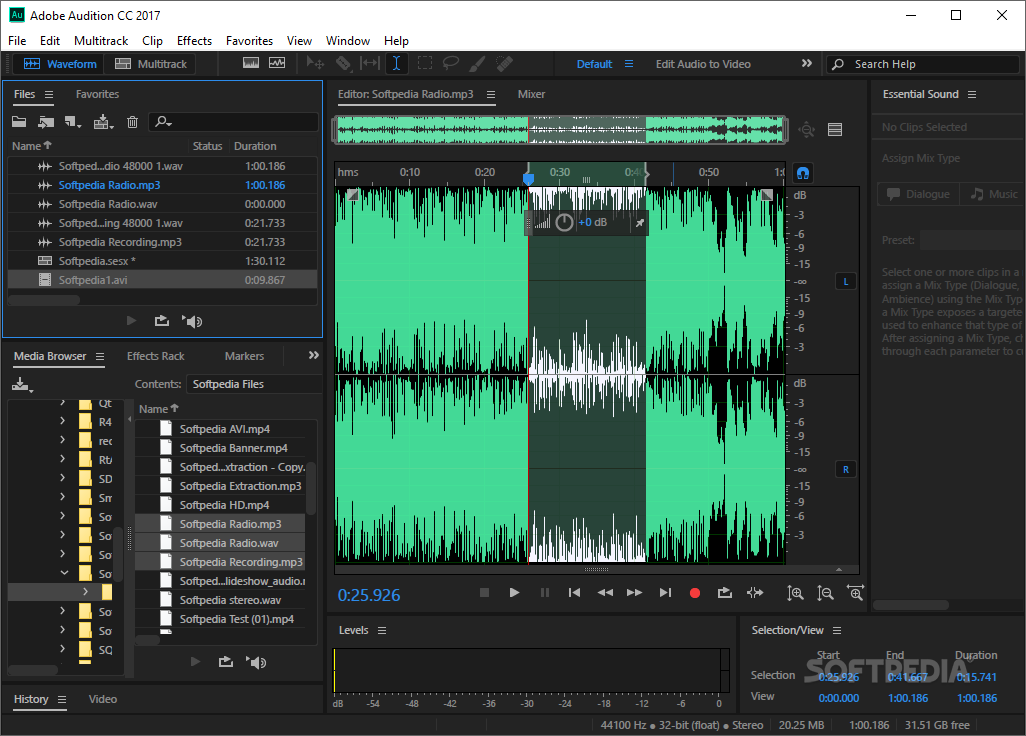For about a year, I lived with the pops, smacks, and clicks that emanated from my mouth while recording episodes for my podcast. I just assumed there was nothing I could do about it… until I realized that I could remove any noise above a certain frequency in Adobe Audition. What this means is that any sound above the frequency of my choosing will be eliminated.
Since my voice typically hovers below 8000 Hz, and those smacking, popping noises are usually present at higher ranges, I can essentially remove all data above 8KHz.
The Adobe Audition CC has been warmly welcomed by music developers since its 2018 launch and is being described as a practical program which boasts an array of features. Designed primarily to not only create songs but also to enhance recordings and craft professional mixes, it certainly lives up to. Latest version: 4.65 Virtual Audio Cable (VAC) is an audio bridge between applications that transmits sounds (audio streams) from app to app, from device to device. Compression A-Z guide (obs, audacity, audition, multiband compressor) What is compression in audio editing softwares (audacity &, Adobe audition)? Compression is a technique to reduce higher volumes above the threshold. By a certain ratio. We can understand that, if audio level goes above. For about a year, I lived with the pops, smacks, and clicks that emanated from my mouth while recording episodes for my podcast.I just assumed there was nothing I could do about it until I realized that I could remove any noise above a certain frequency in Adobe Audition. Compression A-Z guide (obs, audacity, audition, multiband compressor) Adaptive noise reduction Adobe audition how it works how to use it; Setting up OBS with Adobe audition for Live stream Podcast; MySQL Tutorial (create,connect database, update tables, export etc) Documentation & TIPS.
The “Spectral Frequency Display” above shows the most common areas of concentration of my voice. When I hear a smack or a pop during the post-production editing process (typically the result from saliva on the tongue or lips), I can either remove that noise by itself, or simply wipe out the entire frequency range.
Here’s how I do it (screens from the PC version of Adobe Audition ver 3. Your version may be slightly different):
1. When you first load the audio file into Audition, you will see the Waveform Display:
2. Click on View…Spectral Frequency Display (or Shift+F) to see a “heat map” display:
3. With your mouse, highlight the area above the range where most of your voice resides. If it’s hard to tell, just highlight 12000 and up, or 10000 and up. Start somewhere because you can always Undo anything you “do”.
4. Press Delete to remove that range. Play the file, how does it sound? If the pops are gone but the audio sounds too weird, you may need to remove a range slightly higher. Just Undo, and try again.
5. When all else fails, you can tackle each snap, crackle and pop one at a time. Simply highlight the area you want to correct, then delete the sound from that area.
That’s it! If this doesn’t work for you, it’s possible your voice or the sound you are trying to alter has similar frequencies as the pops and clicks. If this is the case, you may need to just cut that tiny piece of audio out altogether, or re-record it. Otherwise, best of luck in your editing adventures.
Step 1: download & Install Virtual Audio Cable

from here https://vb-audio.com/Cable/
understanding VB cable settings
virtual audio cable:
Output = input or recording
input = playback
sound goes to output to >> input >> another hardware. (skype,)
Step 2: Configure sound settings on windows
Playback device: plays sound
Recording device:records
Recording device audio quality settings available at advance tab.
cross check match with input hardware device.
Step 3: Configuration at Adobe Audition
a. Adobe audio hardware properties
input device: actual hardware
output: virtual cable input default
default & master will be same.
microphone input >>Audition>>VB cable output>>
cable input >>at obs
In Multitrack session:
Select Mixer
Input device:
stereo: real input device usb audio codec
output: stereo >> cable input virtual Audio cable VB
Step 2:
Adobe Audition To Observe
Then Select R for Record
Then select I for Monitor
Monitor outputs sound vb cable.
vb cable as a input hardware for obs.
processed audio will come to OBS.
OBS Itself good for audio processing but audacity at professional level.
Troubleshooting
Two Different audio qualities not works together
my case: 16 bit mono 48k for input device
Obs Audio Glitching
VB has setting for 24bit something not worked , so i changed to 16 bit 1 channel usually mics have only one 1 channel.
audio quality should be same
16 bit dvd or whatever the actually input hardproprties.
otherwise voice lose quality for editing.
just like compressing image.
16 bit 48K
Obs And Audacity
Related topics:
